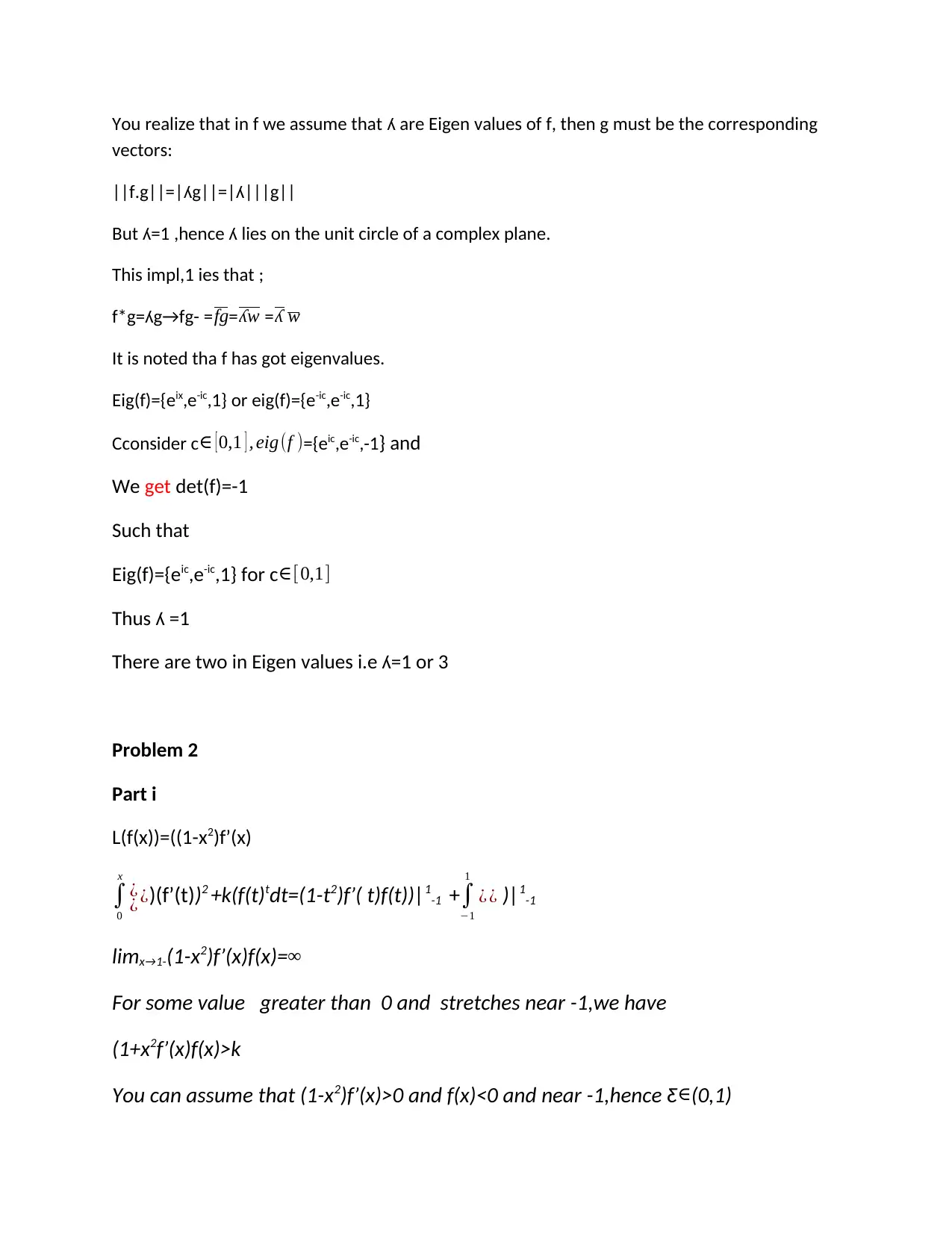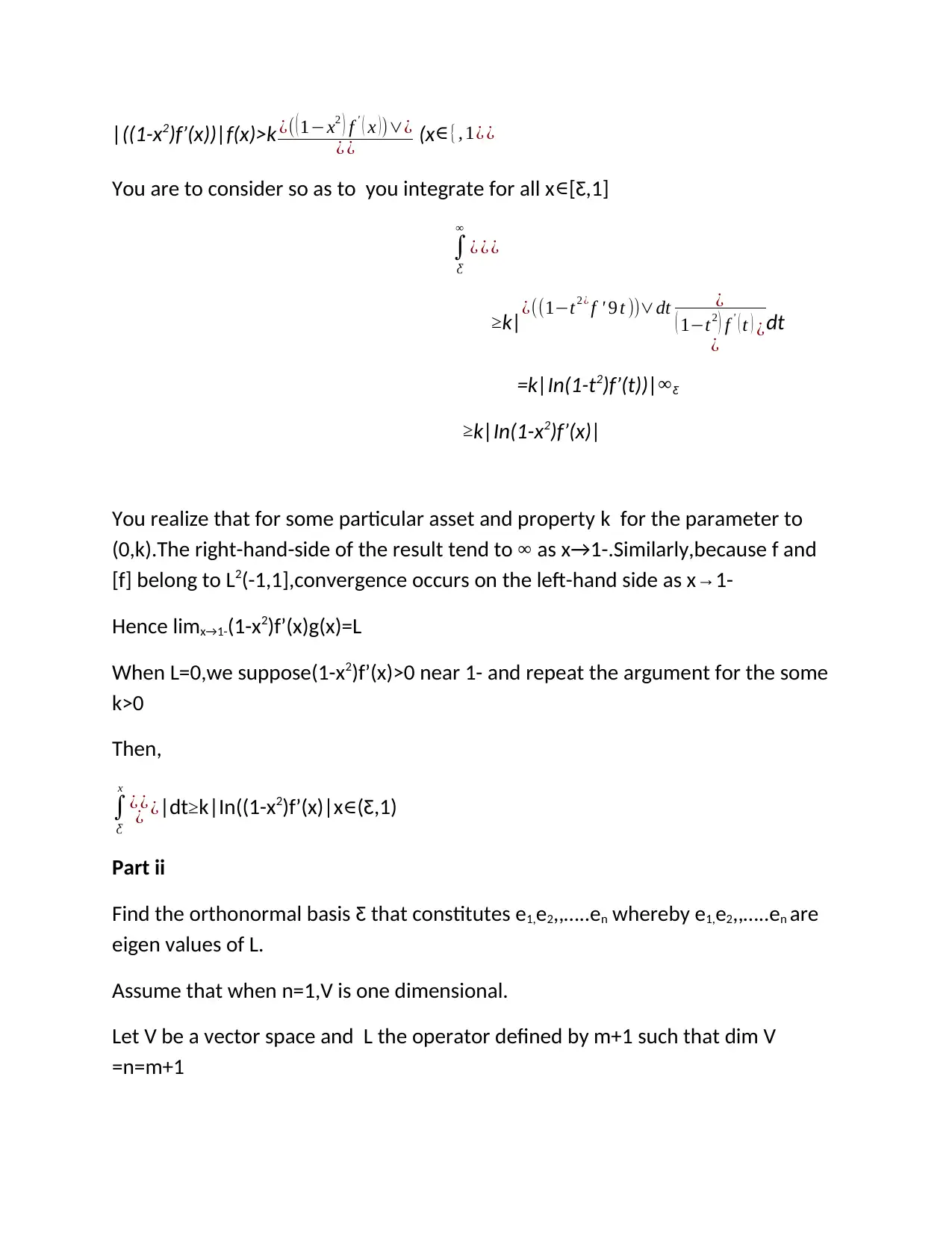Detailed Solutions to Applied Statistics Problems - Physics Homework
VerifiedAdded on 2022/09/02
|6
|942
|23
Homework Assignment
AI Summary
This document presents solutions to a physics homework assignment focusing on applied statistics. The problems involve vector products, linear and invertible mappings, and skew-symmetric matrices. The solutions delve into the properties of scalar products, eigenvalue analysis, and orthonormal bases. It includes the analysis of a differential equation problem, determining the orthonormal basis of a vector space and evaluating the eigenvalues. Additionally, the assignment explores the behavior of a pendulum, including the derivation of a symmetric operator representing its dynamics.

APPLIED STATISTICS
Problem 1
Part i
Let g.f ∈R3 such that the vector product of g * f in parts is read as;
g*f =
[ g 2 f 3−¿ g 3 f 2
g3 f 1−¿ g 1 f 3
g 1 f 2−¿ g 2 f 1 ]
We can see from the above equality that :
[gx]=
[ 0 −g 3 g 2
g 3 0 −g 1
−g 2 g 1 0 ]
This satisfies the condition ;
g*f=[gx]f
Hence g is mapped such that g← →[gx]
From the mapping ,it confirms that g is linear and invertible.
Thus g=-g i.e a skew-symmetric
The elements in the main diagonals in the matrix are zero.
The product of I and the matrix is invertible.
The standard inner product on Rn is given as ;
(g(x),f)=-(f,g) ,
Hence (g(x),f)=-(f(x),g),for all x,f ∈ R∞
Part ii)
From the scalar products properties,For all values of g∈Rn
||f.g||2=f*g.f*g =g.fT*f.g=||g||2
Taking f as a ratio matrix,consider fT.f=1
Problem 1
Part i
Let g.f ∈R3 such that the vector product of g * f in parts is read as;
g*f =
[ g 2 f 3−¿ g 3 f 2
g3 f 1−¿ g 1 f 3
g 1 f 2−¿ g 2 f 1 ]
We can see from the above equality that :
[gx]=
[ 0 −g 3 g 2
g 3 0 −g 1
−g 2 g 1 0 ]
This satisfies the condition ;
g*f=[gx]f
Hence g is mapped such that g← →[gx]
From the mapping ,it confirms that g is linear and invertible.
Thus g=-g i.e a skew-symmetric
The elements in the main diagonals in the matrix are zero.
The product of I and the matrix is invertible.
The standard inner product on Rn is given as ;
(g(x),f)=-(f,g) ,
Hence (g(x),f)=-(f(x),g),for all x,f ∈ R∞
Part ii)
From the scalar products properties,For all values of g∈Rn
||f.g||2=f*g.f*g =g.fT*f.g=||g||2
Taking f as a ratio matrix,consider fT.f=1
Paraphrase This Document
Need a fresh take? Get an instant paraphrase of this document with our AI Paraphraser

You realize that in f we assume that ʎ are Eigen values of f, then g must be the corresponding
vectors:
||f.g||=|ʎg||=|ʎ|||g||
But ʎ=1 ,hence ʎ lies on the unit circle of a complex plane.
This impl,1 ies that ;
f*g=ʎg→fg- =fg= ʎw =ʎ w
It is noted tha f has got eigenvalues.
Eig(f)={eix,e-ic,1} or eig(f)={e-ic,e-ic,1}
Cconsider c∈ [ 0,1 ] , eig(f )={eic,e-ic,-1} and
We get det(f)=-1
Such that
Eig(f)={eic,e-ic,1} for c∈[0,1]
Thus ʎ =1
There are two in Eigen values i.e ʎ=1 or 3
Problem 2
Part i
L(f(x))=((1-x2)f’(x)
∫
0
x
¿
¿ ¿)(f’(t))2 +k(f(t)tdt=(1-t2)f’( t)f(t))|1-1 +∫
−1
1
¿ ¿ )|1-1
limx→1-(1-x2)f’(x)f(x)=∞
For some value greater than 0 and stretches near -1,we have
(1+x2f’(x)f(x)>k
You can assume that (1-x2)f’(x)>0 and f(x)<0 and near -1,hence Ƹ ∈(0,1)
vectors:
||f.g||=|ʎg||=|ʎ|||g||
But ʎ=1 ,hence ʎ lies on the unit circle of a complex plane.
This impl,1 ies that ;
f*g=ʎg→fg- =fg= ʎw =ʎ w
It is noted tha f has got eigenvalues.
Eig(f)={eix,e-ic,1} or eig(f)={e-ic,e-ic,1}
Cconsider c∈ [ 0,1 ] , eig(f )={eic,e-ic,-1} and
We get det(f)=-1
Such that
Eig(f)={eic,e-ic,1} for c∈[0,1]
Thus ʎ =1
There are two in Eigen values i.e ʎ=1 or 3
Problem 2
Part i
L(f(x))=((1-x2)f’(x)
∫
0
x
¿
¿ ¿)(f’(t))2 +k(f(t)tdt=(1-t2)f’( t)f(t))|1-1 +∫
−1
1
¿ ¿ )|1-1
limx→1-(1-x2)f’(x)f(x)=∞
For some value greater than 0 and stretches near -1,we have
(1+x2f’(x)f(x)>k
You can assume that (1-x2)f’(x)>0 and f(x)<0 and near -1,hence Ƹ ∈(0,1)

|((1-x2)f’(x))|f(x)>k ¿( ( 1−x2 ) f ' ( x ))∨¿
¿ ¿ (x ∈{, 1¿ ¿
You are to consider so as to you integrate for all x ∈[Ƹ,1]
∫
Ƹ
∞
¿ ¿ ¿
≥k|¿((1−t2 ¿ f ' 9 t ))∨dt ¿
( 1−t2 ) f ' ( t )
¿ ¿dt
=k|In(1-t2)f’(t))| ∞Ƹ
≥k|In(1-x2)f’(x)|
You realize that for some particular asset and property k for the parameter to
(0,k).The right-hand-side of the result tend to ∞ as x→1-.Similarly,because f and
[f] belong to L2(-1,1],convergence occurs on the left-hand side as x →1-
Hence limx→1-(1-x2)f’(x)g(x)=L
When L=0,we suppose(1-x2)f’(x)>0 near 1- and repeat the argument for the some
k>0
Then,
∫
Ƹ
x
¿ ¿
¿ ¿|dt≥k|In((1-x2)f’(x)|x ∈(Ƹ,1)
Part ii
Find the orthonormal basis Ƹ that constitutes e1,e2,,…..en whereby e1,e2,,…..en are
eigen values of L.
Assume that when n=1,V is one dimensional.
Let V be a vector space and L the operator defined by m+1 such that dim V
=n=m+1
¿ ¿ (x ∈{, 1¿ ¿
You are to consider so as to you integrate for all x ∈[Ƹ,1]
∫
Ƹ
∞
¿ ¿ ¿
≥k|¿((1−t2 ¿ f ' 9 t ))∨dt ¿
( 1−t2 ) f ' ( t )
¿ ¿dt
=k|In(1-t2)f’(t))| ∞Ƹ
≥k|In(1-x2)f’(x)|
You realize that for some particular asset and property k for the parameter to
(0,k).The right-hand-side of the result tend to ∞ as x→1-.Similarly,because f and
[f] belong to L2(-1,1],convergence occurs on the left-hand side as x →1-
Hence limx→1-(1-x2)f’(x)g(x)=L
When L=0,we suppose(1-x2)f’(x)>0 near 1- and repeat the argument for the some
k>0
Then,
∫
Ƹ
x
¿ ¿
¿ ¿|dt≥k|In((1-x2)f’(x)|x ∈(Ƹ,1)
Part ii
Find the orthonormal basis Ƹ that constitutes e1,e2,,…..en whereby e1,e2,,…..en are
eigen values of L.
Assume that when n=1,V is one dimensional.
Let V be a vector space and L the operator defined by m+1 such that dim V
=n=m+1
⊘ This is a preview!⊘
Do you want full access?
Subscribe today to unlock all pages.

Trusted by 1+ million students worldwide

L={x ∈V |x=αe1 for some α ∈ R }
Assume that M=LĻ={v∈V |cv,e1)=0}
Therefore,
L+M=V ,and dim M=dimV-dimL=(m+1)-1=m
For y∈M≡LĻ
<Ty,e1>=(y,Te1)>=<y,ʎ1e1>0
Sx =Tx for x ∈M
Hence S is a linear operator of M
M is a subspace of V whereby x ∈is such thatTx∈M
You realize that T is a symmetric operator with the condition:
(Tx,y)>=<(x,Ty) for Vx,y∈V
But note that <Sx,y>=<x,Sy> .Hence S is also a symmetric operator of M.
Thus m+1,visits e1,e2,……em+1 form an orthonormal basis of V with the Eigen values
with the Eigen vectors of T.Hence M is a symmetric operator.
Part iii
The Eigen values of L are given by:
ʎn+2= n ( n−1 ) −l(1+l)
(n+1)(n+ 2) ʎn
−l ( l+1( n+ 1)¿ ) (l−n)
(n+1)(n+2) ʎn
When n=0;
ʎ 2=−l ¿ ¿ʎ0
Assume that M=LĻ={v∈V |cv,e1)=0}
Therefore,
L+M=V ,and dim M=dimV-dimL=(m+1)-1=m
For y∈M≡LĻ
<Ty,e1>=(y,Te1)>=<y,ʎ1e1>0
Sx =Tx for x ∈M
Hence S is a linear operator of M
M is a subspace of V whereby x ∈is such thatTx∈M
You realize that T is a symmetric operator with the condition:
(Tx,y)>=<(x,Ty) for Vx,y∈V
But note that <Sx,y>=<x,Sy> .Hence S is also a symmetric operator of M.
Thus m+1,visits e1,e2,……em+1 form an orthonormal basis of V with the Eigen values
with the Eigen vectors of T.Hence M is a symmetric operator.
Part iii
The Eigen values of L are given by:
ʎn+2= n ( n−1 ) −l(1+l)
(n+1)(n+ 2) ʎn
−l ( l+1( n+ 1)¿ ) (l−n)
(n+1)(n+2) ʎn
When n=0;
ʎ 2=−l ¿ ¿ʎ0
Paraphrase This Document
Need a fresh take? Get an instant paraphrase of this document with our AI Paraphraser

When n=2
ʎ 4=−l(−2)(l+3)
3.4 ʎ0
When n=4,
ʎ6=¿ ¿ʎ0
Even solutions of Eigen Values;
Y1(x)= 1+∑
n=1
∞
( −1 ) n [ ( l−2 n +2 ) ….. ( l −2 ) l ] [ l ( l +1 ) ( l +3 ) ] … ¿
(2 n)!
When the Eigen values are odd solutions;
Y2(x)= x+∑
n=1
∞
(−1 )n [ (l−2 n+1 ) …. (l−3 ) (l−1 ) ] [ 9 l+2 ) (l+ 4 ) … ( l+ 2n ]
( 2 n+1 ) !
x2m+1
Pn(x)=Cn{ y 1 ( x ) for l even
y 2 ( x ) for l odd
Problem 3
Given that H(f(x))= h2
m L2 f’’(x) +mgL(1-COS(x)f(x)
HH(t)= P(t )
2m + 1
2mw2x2h2(t)
= 1
2m (ecoswt –mwx^sinwt)2 + 1
2mw2(x^coswt + 1
mw e^sinwt)2
= cos2 wt ❑
2m p2 + m2 w2 sin2 ❑
2 x^2 - w
2 sinwtcoswt(e^x+x^p^)
+ sin2 wt
2 m p^2 + mw2 cos2 w
2 x^2 + w
2 coswtsinwt(x^p^ +p^x^)
ʎ 4=−l(−2)(l+3)
3.4 ʎ0
When n=4,
ʎ6=¿ ¿ʎ0
Even solutions of Eigen Values;
Y1(x)= 1+∑
n=1
∞
( −1 ) n [ ( l−2 n +2 ) ….. ( l −2 ) l ] [ l ( l +1 ) ( l +3 ) ] … ¿
(2 n)!
When the Eigen values are odd solutions;
Y2(x)= x+∑
n=1
∞
(−1 )n [ (l−2 n+1 ) …. (l−3 ) (l−1 ) ] [ 9 l+2 ) (l+ 4 ) … ( l+ 2n ]
( 2 n+1 ) !
x2m+1
Pn(x)=Cn{ y 1 ( x ) for l even
y 2 ( x ) for l odd
Problem 3
Given that H(f(x))= h2
m L2 f’’(x) +mgL(1-COS(x)f(x)
HH(t)= P(t )
2m + 1
2mw2x2h2(t)
= 1
2m (ecoswt –mwx^sinwt)2 + 1
2mw2(x^coswt + 1
mw e^sinwt)2
= cos2 wt ❑
2m p2 + m2 w2 sin2 ❑
2 x^2 - w
2 sinwtcoswt(e^x+x^p^)
+ sin2 wt
2 m p^2 + mw2 cos2 w
2 x^2 + w
2 coswtsinwt(x^p^ +p^x^)

= p2
2m +1
2mw2x^2
Hence H is a symmetric operator ,given that the mass of the pendulum is m and
the lenghth is l.
2m +1
2mw2x^2
Hence H is a symmetric operator ,given that the mass of the pendulum is m and
the lenghth is l.
⊘ This is a preview!⊘
Do you want full access?
Subscribe today to unlock all pages.

Trusted by 1+ million students worldwide
1 out of 6
Related Documents
Your All-in-One AI-Powered Toolkit for Academic Success.
+13062052269
info@desklib.com
Available 24*7 on WhatsApp / Email
![[object Object]](/_next/static/media/star-bottom.7253800d.svg)
Unlock your academic potential
Copyright © 2020–2025 A2Z Services. All Rights Reserved. Developed and managed by ZUCOL.





